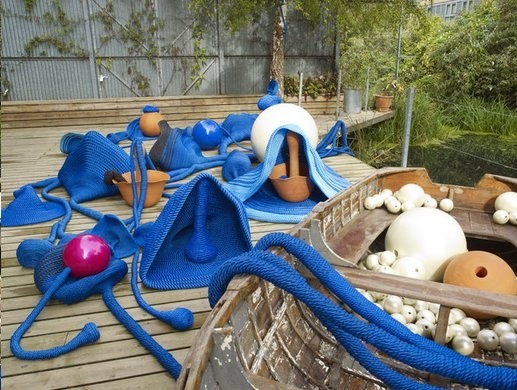Maria Nepomuceno
12 Oct - 12 Nov 2011
MARIA NEPOMUCENO
The Force
12 October - 12 November, 2011
Victoria Miro is pleased to present new work by Brazilian artist Maria Nepomuceno, whose seductive sculptures and installations made of brightly coloured rope, straw, ceramic and beads spread throughout the spaces they inhabit: they varyingly hang in hammock-like forms, drape down walls, sprawl across floors, or group together as constellations in a new and curious cosmos. Each of the materials Nepomuceno employs represents one of four elements in nature - Water, Fire, Earth, Air - and she strives in her sculptures to achieve a delicate, rhythmic equilibrium amongst these.
Maria Nepomuceno allows her materials to obey their own organisational logic, weaving them together in a process that presents seemingly infinite possibilities for the spiralling, circling and multiplying of forms. Inspired by ancient traditions and complex indigenous craft techniques, Nepomuceno pushes these into a wholly contemporary engagement with space and structure, form and concept. That the sculptures appear anthropomorphic and organic is essential to a reading of her work.
For this project, Nepomuceno has created a large-scale outdoor installation to occupy the gallery's canalside garden. Entitled The Force, the work appears to rise from the water as if compelled by a cyclonic energy, expanding and spilling over onto the terrace. One of the references for this work is Yemanjá, an Orixá (divinity) of the Afro-Brazilian Candomblé religion revered in Brazilian culture as the Queen of the Sea. Personified as a beautiful woman, proud of her feminine vanity, Yemanjá stands for fertility, life cycles and maternity: the sea as the womb of the Earth. As it sprawls, The Force alternates between gentleness, as it balances feminine forms, and aggressiveness, as it appears to drag along a boat found in its path.
Force also appears here as a synonym for resistance. The rope used as a material for this work is one which requires brute force to sew by hand, and embodies resistance in both the physical sense (there is a physical struggle in the attempt to subdue this material), and in the sense of cultural resistance, as it creates a counterpoint to a reality that is more and more technological, virtual, nearly intangible, and one in which we have lost the capacity to understand the processes that have formed the world around us. These processes, laborious and time-consuming, seem at odds with the rapid pace of contemporary life, and the work inhabits a suspended state of infinite, non-identifiable time.
The Force
12 October - 12 November, 2011
Victoria Miro is pleased to present new work by Brazilian artist Maria Nepomuceno, whose seductive sculptures and installations made of brightly coloured rope, straw, ceramic and beads spread throughout the spaces they inhabit: they varyingly hang in hammock-like forms, drape down walls, sprawl across floors, or group together as constellations in a new and curious cosmos. Each of the materials Nepomuceno employs represents one of four elements in nature - Water, Fire, Earth, Air - and she strives in her sculptures to achieve a delicate, rhythmic equilibrium amongst these.
Maria Nepomuceno allows her materials to obey their own organisational logic, weaving them together in a process that presents seemingly infinite possibilities for the spiralling, circling and multiplying of forms. Inspired by ancient traditions and complex indigenous craft techniques, Nepomuceno pushes these into a wholly contemporary engagement with space and structure, form and concept. That the sculptures appear anthropomorphic and organic is essential to a reading of her work.
For this project, Nepomuceno has created a large-scale outdoor installation to occupy the gallery's canalside garden. Entitled The Force, the work appears to rise from the water as if compelled by a cyclonic energy, expanding and spilling over onto the terrace. One of the references for this work is Yemanjá, an Orixá (divinity) of the Afro-Brazilian Candomblé religion revered in Brazilian culture as the Queen of the Sea. Personified as a beautiful woman, proud of her feminine vanity, Yemanjá stands for fertility, life cycles and maternity: the sea as the womb of the Earth. As it sprawls, The Force alternates between gentleness, as it balances feminine forms, and aggressiveness, as it appears to drag along a boat found in its path.
Force also appears here as a synonym for resistance. The rope used as a material for this work is one which requires brute force to sew by hand, and embodies resistance in both the physical sense (there is a physical struggle in the attempt to subdue this material), and in the sense of cultural resistance, as it creates a counterpoint to a reality that is more and more technological, virtual, nearly intangible, and one in which we have lost the capacity to understand the processes that have formed the world around us. These processes, laborious and time-consuming, seem at odds with the rapid pace of contemporary life, and the work inhabits a suspended state of infinite, non-identifiable time.

